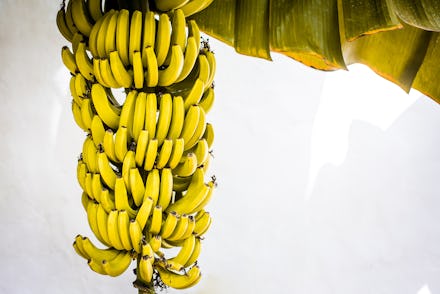A devastating fungus might kill off the world's yellow bananas

Our days of grabbing a yellow banana for an cheap and easy snack may be at risk due to a devastating fungus that threatens to destroy the fruit, as we know it, forever. The fungus, called Tropical Race 4 (TR4), has already freaked out researchers and industry workers as it killed crops in a number of Asian countries. Now, as experts feared would happen, the fungus has spread even further. Earlier this month, the Colombian Agricultural Institute declared a national emergency, warning that lab tests have confirmed TR4 in Latin American banana plantations, and enacted drastic measures to keep the fungus contained.
But it may be too late. The fungus lives in the soil, attacking the roots of banana plants and preventing them from getting water and nutrients. TR4 essentially starves the plants over the course of a year — by the time the symptoms are visible, it's already too late to save them. On top of that, since the fungus can be hidden from sight for such a long time, it's also easy to spread. People walking on infected soil can then transfer it to other plantations, where the fungus can latch onto other banana plants.
Preventing the spread of the fungus is one thing, but fighting against it is another. Banana industry experts are hard-pressed to find a weapon that can get rid of TR4. Older variations of this fungus (such as TR1) have eradicated banana crops since the 1990s. Researchers back then also struggled to find solutions that could stop it.
The best option was replacing the vulnerable bananas with a different, resistant breed. Companies like Dole had no choice but to switch the dominant banana breed, the Gros Michael, to the slightly more bland Cavendish banana we know today.
This time, TR4 can kill the Cavendish. And, unfortunately, no one has a similar-looking, resistant breed that can replace it. Although researchers have been hard at work trying to beat the fungus and its ever-evolving strains, there are a number of obstacles that make their task difficult.
First is the low cost of the fruit. According to Wired, the price of bananas has remained relatively low throughout the last ten years. In contrast, other fruits, like apples, have increased nearly 40 percent in price. Maintaining this low cost can put a hit on funding for research that can contribute towards finding new, fungus-resistant bananas.
Second is the industry's dependence on a single variety of banana. National Geographic explained that consumers are fixated on the popular image of a banana — the familiar yellow, curved fruit — and have historically rejected any other bananas that were introduced during the '90s.
The consumer attitude contributes to the industry's decision to invest in only one type of banana. This lack of biodiversity is what makes the fungus deadly to global banana plantations; it means all the bananas are vulnerable with no other crops that can stand up to certain fungal infections.
The third challenge is the difficulty of breeding the banana. To crossbreed a banana, specialists need to take the type with seeds and breed them to make the banana they want. Then, that banana needs to become the seedless version people buy from stores. According to NPR, this is an astoundingly challenging task. Very few people have done it.
To get around this, bananas can be genetically modified to become stronger against infections. But the negative public outlook on GMOs and increasing regulations that limit the sale of genetically modified produce has thrown a wrench in that as a possible solution to the banana problem.
The devastation from the fungus will be slow, researchers reassure, but it will happen. So, what's left to prevent a global banana shortage? Scientists have said that both producers and consumers need to embrace biodiversity and change their minds on seeing a single type of banana in the market.
"A lot of people are saying that rethinking the whole production system is really what we need to be doing," Dan Bebber, senior lecturer in biosciences at Exeter University, told Wired. "With this kind of production system, you’re asking for trouble."
Rony Swennen, a professor who maintains the International Musa Germplasm Collection, where he collects over 1,500 varieties of bananas, seemed to agree in a response to National Geographic.
"[T]here are other varieties with other colors, and other shapes, and other yields, which will survive TR4," Swennen said. "The question is, will the industry accept it, and are the customers ready to change to another taste?"